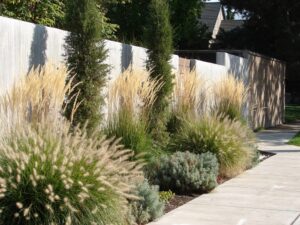
For many people, creating a landscape that fits their aesthetic goals and budget while also fitting the climate’s needs can be a challenging problem. Yet, xeriscaping is an option for many people. This is a type of drought-resistant landscaping that can create surprisingly beautiful and lush landscapes without the need for extensive watering.
Xeriscaping is any type of design that minimizes water consumption. For areas where rain is not consistent and can be limited for long periods of time, this type of landscaping can be critically important. The key is designing the space specifically to be drought-resistant, and there are several ways to do that.
At Siara Designs®, our professional Dallas landscaping design and installation service serves the North Texas area, where we know the local climate is always conducive to heavy watering, nor is that ideal for the environment as a whole. We work with our clients to offer beautiful options. If you are ready, set up a consultation to speak to our team now to discuss the best options for your landscape goals.
What Are the Benefits of Xeriscaping?
Xeriscaping offers a number of benefits depending on where it is used and how it is applied. Keep in mind that this method does not mean “zero” landscaping. Rather, it means designing your space with water conservation and drought conditions in mind.
That means there are a lot of benefits that property owners can reap from this process. While each landscape design is a bit different, we can design a space that fits your specific goals. Some of the benefits that can be achieved through this method of landscaping include the following.
Water Conservation
Even if it rains every day where you live, xeriscaping can be a very important tool in reducing your impact on the environment as a whole. If you want to do your part to minimize the impact on the environment, this is one simple way to do so. It simply conserves precious water.
It Lowers Water Bills
For property owners who have high water bills, watering the lawn is not going to be ideal for your budget. However, with the help of xeriscaping, you do not have to do that, and you can still have a beautiful space. If you want a beautiful landscape without the added costs, this is one way to make that happen.
It’s a More Natural Landscape
Xeriscaping relies on the premise that spaces should be designed using natural, local species that are already used to and adapted to the environment. Instead of trying to make a plant that needs significant water do well in an area with little, you choose plants that are native to the area. If you want a more natural look, this is the route to take.
How does Xeriscaping Work?
There are a few different concepts that play a role in the effectiveness of using xeriscaping as your landscaping choice. As you work with your landscape designer, our team will design a space that fits your needs based on your budget and overall goals. You can expect to discuss a wide range of factors throughout this process.
One of the things you will learn is that you can use drought-resistant and drought-tolerant plants in your space, depending on the level of concern present. Drought-resistant plants are those that can do well when there are drought conditions consistently in the area, and they do not need much human intervention. Drought tolerant are those that can handle droughts for a period of time but still need a bit of watering to keep going.
Considering this, work to choose plants that are suitable for the conditions you expect to face. That includes dealing with grass, which is sometimes the biggest demand for water. Our design team will help you choose a few different options that appeal to all of your needs.
Design Your Yard to Be Drought Resistant One Step at a Time
Take a look at the current layout of your yard. What areas of it are the least used and, therefore, the first places to start when making a switch to xeriscaping? You do not have to tackle the entire location at once.
Design water zones based on the amount of watering the plants in any given area need. For example, in zone one, sometimes called the oasis zone, you have plants that are going to need the most watering and support. In the Transition zone, or zone two, the focus is on plants that can handle less watering but still need some support.
The third area is the xeric zone, which is typically located the furthest from the home and is filled with plants that do not need much human attention or water. That furthest location is typically where you want to start installing this type of landscape. That way, you will have a more gradual transition that appeals to most.
Look at Replacement Options with Care
There are a number of factors to consider when moving to xeriscaping, and one of them is replacing the lawn. You can remove much (or all) of the lawn if you would like to and replace it with non-living substances to eliminate the need for watering. Common options include, but are not limited to:
- Mulch
- Rocks
- Gravel
This is a solid option if you are planning to fully remove the lawn, though. To minimize the growth of weeds, you’ll need to remove all growing grass, cover and protect the area, and then use rocks and gravel that do not lend themselves to weed growth. Otherwise, you have to deal with a much higher level of maintenance, which we can assist with based on our customer reviews.
Call Siara Designs Today
Do not assume a lawn without grass cannot be beautiful and even stunning. This is especially true when you incorporate various types of materials in an aesthetically pleasing way. Our team can offer the support and guidance you need to create a space you love, and all you have to do is give Siara Designs a call in Dallas to set up a consultation.

